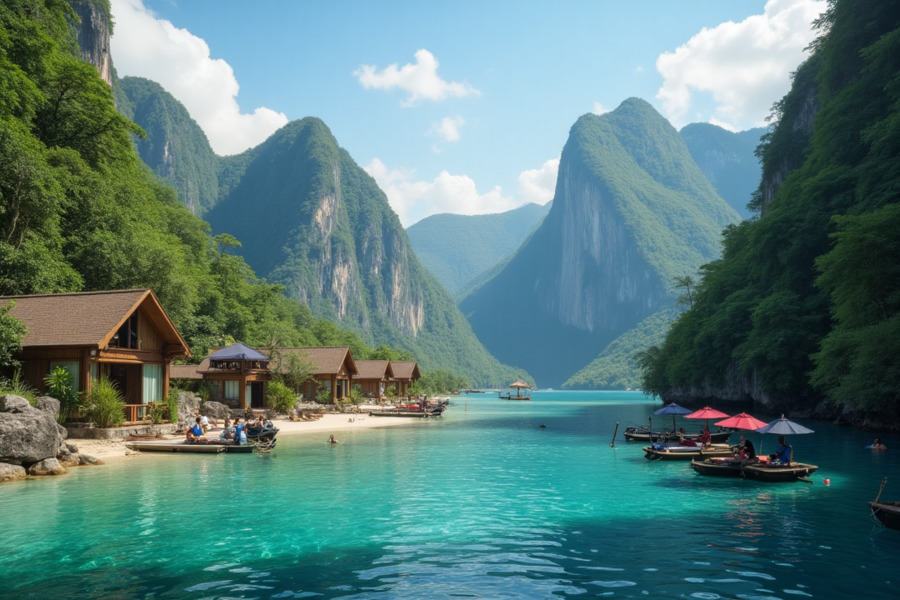≡-From Megaquake to Emergency Landings, How Japan Tourism Facing the Impact of a Viral Prophecy, Is This Fiction or Start of New Travel Chaos – Viral of Today
<> Viral of Today <>
Home » ASIA » From Megaquake to Emergency Landings, How Japan Tourism Facing the Impact of a Viral Prophecy, Is This Fiction or Start of New Travel Chaos Tuesday, July 1, 2025From Megaquake fears to shocking Emergency Landings, Japan Tourism is under siege like never before. Meanwhile, the world watches how it’s facing a swirling storm of rumors and reality. And the impact of a Viral Prophecy is exploding into new travel chaos that few saw coming. Tourists are panicking now. Any flights are changing course. and any hotels stand half-empty as whispers of doom spread faster than jet engines roar.However, questions rage louder than the shaking ground. Will the so-called Megaquake strike? Could emergency landing drills turn real? How deeply will Japan Tourism bleed under the weight of fear and fiction colliding? Moreover, the Viral Prophecy has travelers questioning every ticket, every plan. And as July draws closer, tension coils tighter. Get ready, because new travel chaos is here. And the story lurking beneath could change how the world sees Japan forever.A Prophecy Goes Viral, Sparking ChaosManga Artist at Center of PanicA decades-old comic has ignited a tourism crisis in real time. Ryo Tatsuki, a manga artist, penned a chilling prophecy back in 1999. Her work hinted at disasters that eerily mirrored Japan’s deadly 2011 tsunami.Now, she’s back in the spotlight for an even more ominous prediction—a colossal earthquake and tsunami supposedly set to strike Japan between July 5 and 7.Despite lacking any scientific basis, her words have exploded across social media, transforming into viral posts and emotional warnings shared by influencers, travelers, and anxious citizens.The Power of Viral FearJapan is no stranger to earthquakes. Yet fear thrives not just on seismic risks, but on the memory of past tragedies. The trauma of the 2011 tsunami still lingers in the national psyche.As a result, even unfounded predictions strike a raw nerve. And this time, the economic fallout is threatening to rival the emotional shockwaves.Travel Industry Reels But Bookings are Collapsing?Airlines Forced to Cut FlightsThe prophecy’s first major casualty is the airline sector. Demand for Japan-bound travel has evaporated across key markets like Hong Kong, South Korea, and Taiwan.Hong Kong Airlines has scrapped all flights to Kagoshima and Kumamoto for July and August. Other regional carriers are on high alert, bracing for further schedule cuts if passenger confidence doesn’t rebound.Travelers simply aren’t willing to take the chance—however small—of landing in Japan during the forecasted disaster window.Hotels Facing Empty RoomsHotels in Japan’s most beloved destinations—from Tokyo’s neon streets to Kyoto’s tranquil temples—are watching cancellations spike.Rooms once booked months in advance now sit vacant, as travelers flee itineraries once dreamed of as bucket-list adventures.Hoteliers are slashing rates and rolling out flexible cancellation policies to lure guests back. Yet fear remains a stubborn obstacle.Tourism Economies on EdgeLocal Businesses Fear a Summer DroughtBeyond airlines and hotels, local economies stand exposed. Countless small businesses depend on the summer surge of visitors who shop, dine, and explore.From kimono rental shops in Kyoto to souvenir stalls in Nara, many fear this prophecy-fueled panic could rob them of critical income.The timing couldn’t be worse. Japan’s tourism sector was riding high, poised to exceed pre-pandemic visitor levels in 2025. Now, analysts warn July’s arrivals could plunge by up to 20% if fear keeps spreading.Ripple Effects Across AsiaMeanwhile, the impact isn’t contained within Japan’s borders. Asia’s interconnected travel ecosystem feels the tremors.Insurance companies report spikes in inquiries as travelers demand coverage for potential disasters—even hypothetical ones.Online travel influencers who normally flood Instagram with cherry blossom snaps and sushi reels are pivoting to cautionary posts, fueling a feedback loop of fear.Authorities Battle the Rumor TsunamiGovernment Pleads for CalmJapan’s government is moving fast to stem the tide. Officials stress that no scientific method exists to predict earthquakes with exact dates, times, or places.Seismologists worldwide agree: earthquakes strike without warning. Yet their calm logic struggles to overpower viral narratives swirling through TikTok, X, and regional message boards.Tourism Campaigns Try to Rebuild TrustTourism authorities are fighting back with fresh campaigns. They’re highlighting Japan’s world-class safety measures, robust infrastructure, and readiness to protect visitors during emergencies.However, reputational damage has already taken root. Even if no earthquake arrives in July, some travelers may think twice about future trips.Japan’s tourism industry is facing turbulence, fueled by viral prophecies and travel uncertainty. However, wanderlust doesn’t pause for rumors.Japan’s Tourism Roller Coaster: Booming Arrivals and New Fears Collide in 2025Japan’s tourism industry is living through a year of contrasts. On one hand, record-breaking visitor numbers are surging in, pumping fresh life and billions into the economy. On the other, swirling anxieties fueled by viral rumors and overtourism are testing the country’s resilience like never before.As July 2025 unfolds, Japan stands at a crossroads. The nation’s travel sector is riding a powerful wave of success — but storm clouds are gathering on the horizon.A Roaring Comeback: Record Visitors Flood Japan’s StreetsFew countries have bounced back from the pandemic as dramatically as Japan. By mid-2025, foreign arrivals are smashing records month after month. Airports are packed, trains run brimming with excited tourists, and hotels from Tokyo to Kyoto are fully booked weeks in advance.The numbers tell a story of triumph. Millions of travelers from around the world — especially the United States, South Korea, Taiwan, and Europe — are pouring into Japan’s vibrant cities, tranquil temples, and scenic mountains.From cherry blossom chasers in spring to summer festival seekers, Japan’s magnetic pull is undeniable. The country’s blend of futuristic cityscapes, ancient traditions, and mouthwatering cuisine has kept it firmly at the top of global bucket lists.Travelers are splashing out on luxury stays, Michelin-starred dining, unique cultural experiences, and shopping sprees in bustling districts like Shibuya and Ginza. This tidal wave of spending is proving a lifeline for local businesses and the broader economy.Economic Boom: Tourism Dollars Pour InBeyond the beauty of temples and neon lights, there’s hard cash changing hands. Tourism has become a crucial pillar of Japan’s economy in 2025.Foreign visitors are not merely sightseeing — they’re spending big. Hotels, restaurants, shops, transportation services, and entertainment venues are all cashing in on the influx of travelers. For Japan’s hospitality sector, these tourists are the oxygen fueling growth and stability.Local governments, once starved for revenue during pandemic lockdowns, are now enjoying a financial windfall. Tax collections are rising thanks to bustling tourism. Jobs have surged back in travel-related industries, offering new hope to communities nationwide.Japan’s national tourism authorities have set ambitious goals, aiming to surpass 40 million inbound tourists for the full year, with eyes on even higher figures in the years ahead.Overtourism Strikes: Beautiful Places Under PressureBut there’s a flip side to this booming success. Popular destinations like Kyoto, Mount Fuji, and Osaka’s vibrant districts are groaning under the weight of surging tourist numbers.Streets in historic neighborhoods grow congested, once-serene temples echo with chatter and camera clicks, and local residents voice rising frustration over disrespectful visitor behavior.Mount Fuji has become a symbol of this struggle. Thousands of climbers now line its trails daily during peak season, prompting new restrictions, visitor caps, and entrance fees designed to protect the fragile ecosystem.Kyoto’s iconic geisha districts have introduced fines for tourists harassing performers or trespassing into private areas. Signs urging respect and quiet fill popular lanes.The challenge for Japan is clear: how to welcome millions of tourists without eroding the very beauty and tranquility travelers come to experience.Viral Prophecy Panic: When Fiction Shakes RealityAs if overtourism weren’t enough, Japan is facing an unexpected problem this summer — an explosion of fear sparked by a viral prophecy.A decades-old manga artist’s prediction about a catastrophic earthquake hitting Japan in early July 2025 has gone viral across social media. Though entirely unscientific, the rumor has taken on a life of its own, stoking genuine fear among potential visitors.Travelers across Asia and beyond are suddenly second-guessing their plans. Airlines have reported slumping bookings. Some carriers have cut routes to southern regions like Kagoshima and Kumamoto due to waning demand.Hotels are seeing nervous cancellations, particularly for stays scheduled around the dates tied to the prophecy.For Japan’s tourism industry, it’s a surreal nightmare: battling not an actual earthquake, but the economic tremors caused by viral misinformation.The Government Fights Back: Science vs. RumorJapan’s government and tourism bodies are working overtime to calm the storm. Officials are publicly reminding travelers that earthquakes can’t be predicted to specific days or hours.Seismologists and experts continue to assure the public that while Japan sits atop active tectonic zones, no credible science can pinpoint an exact disaster date.Meanwhile, tourism authorities are flooding media with positive messaging. They’re highlighting Japan’s safety protocols, advanced infrastructure, and readiness to protect residents and visitors alike.Industry players — from travel agencies to airlines — are offering flexible bookings, extra insurance coverage, and reassurance campaigns to help nervous travelers keep their plans intact.Cruise Tourism and the Osaka Expo: Big Bets for StabilityDespite the viral quake fears, many segments of Japan’s travel sector remain optimistic. Cruise tourism, for example, is booming. Ports across Japan are preparing for record arrivals of cruise ships through the summer and into fall.Meanwhile, the much-anticipated Osaka Expo 2025 is already drawing global attention. Running from April to October, it promises to attract tens of millions of domestic and international visitors.The Expo is a powerful counterbalance to any temporary slowdown. It’s fueling new hotel openings, transportation upgrades, and promotional campaigns — and serves as a symbol of Japan’s confidence in its future as a tourism powerhouse.Eyes on Sustainability and Long-Term GrowthJapan’s tourism leaders know that simply chasing bigger numbers isn’t enough. The conversation is shifting toward sustainability and balance.Cities and regions are developing strategies to spread tourists more evenly across the country. Hidden gems and rural areas are being promoted to reduce strain on big cities. New cultural experiences and eco-tourism offerings aim to entice visitors off the beaten path.Digital technology is also being leveraged to manage crowds. Apps alert travelers to real-time congestion levels, nudging them toward quieter times or alternative sites.Japan wants to ensure its growth story continues — but without sacrificing the serenity and cultural heritage that make it so beloved.Japan Stands Resilient: A Summer of Uncertainty and HopeAs July 2025 progresses, Japan’s tourism industry stands at a pivotal moment. Record-breaking arrivals have proven that global travelers remain enchanted with the Land of the Rising Sun.Yet overtourism pressures and viral prophecy panic reveal how fragile the industry can be. Japan’s response — balancing science, sustainability, and marketing savvy — will determine how smoothly it sails through these choppy waters.One thing is certain: Japan remains firmly on the world’s travel radar. Whether visitors arrive this summer or delay their plans, the country’s allure endures.In the face of rumors and reality, Japan’s tourism sector is betting that its unique blend of beauty, hospitality, and innovation will keep travelers coming back for years to come.A Destination Guide For US and Canadian travelers wary of visiting Japan in 2025, the world remains wide open. Many destinations deliver dazzling culture, gorgeous scenery, and memorable experiences—all without stepping foot in Tokyo or Kyoto.Let’s explore where you should go next if Japan’s off your radar.South Korea: Seoul’s Vibrant Pulse and Jeju’s Natural WondersSeoul: A Dynamic Urban PlaygroundIf Japan’s energy captivated you, Seoul is ready to steal your heart. The city buzzes with neon lights, cutting-edge technology, and endless street food alleys.Shoppers will find paradise in Myeongdong’s cosmetic stores and fashion boutiques. Meanwhile, history buffs can wander Gyeongbokgung Palace’s regal courtyards, where ancient dynasties once ruled.Seoul also boasts a thriving café culture, perfect for slow mornings or people-watching. And K-pop fans can indulge in concerts and memorabilia shops scattered across the city.Jeju Island: Nature’s Secret GardenBeyond the city lights lies Jeju Island—a volcanic haven brimming with emerald forests, lava tubes, and idyllic waterfalls.Hike Hallasan Mountain for panoramic views, or explore the island’s serene beaches. The island’s unique “haenyeo,” or female divers, offer glimpses into centuries-old cultural traditions.Moreover, South Korea’s proximity and excellent infrastructure make it a smart, seamless substitute for travelers pivoting from Japan.Taiwan: Culture, Cuisine, and Scenic LandscapesTaipei’s Urban HeartbeatTaiwan delivers an intoxicating mix of tradition and modernity. Taipei gleams with futuristic skyscrapers, yet temple incense and night markets keep ancient customs alive.Travelers craving food adventures should dive into Shilin Night Market’s culinary maze, sampling everything from stinky tofu to bubble tea.Meanwhile, Taipei 101 offers sky-high views of the cityscape, perfect for those missing Tokyo’s city lights.Nature Awaits Beyond the CityFor peace and breathtaking scenery, Taiwan’s Taroko Gorge astounds with marble cliffs and turquoise rivers. Sun Moon Lake offers serene boat rides surrounded by misty hills.Taiwan remains safe, affordable, and highly accessible—a compelling alternative for those side-stepping Japan this year.Vietnam: Affordable Adventures and Deep CultureHanoi’s Historic AllureHanoi radiates old-world charm. Narrow streets overflow with scooters, food stalls, and French colonial architecture.History pulses through every corner. From the Ho Chi Minh Mausoleum to the tranquil Temple of Literature, travelers will feel history breathing beneath modern life.Moreover, Vietnam’s affordability stretches travel budgets further than Japan ever could.Natural Beauty from North to SouthHalong Bay dazzles with emerald waters and towering limestone karsts. Meanwhile, central Vietnam’s ancient town of Hoi An charms with lantern-lit nights and riverside cafés.In the south, Ho Chi Minh City bustles with energy, blending modern skyscrapers with vibrant street markets.Vietnam offers a kaleidoscope of experiences without breaking the bank—a solid option for travelers seeking culture and value.Spain: European Charm and Diverse ExperiencesBarcelona’s Art and ArchitectureFor travelers seeking culture, Spain steps up as a global heavyweight. Barcelona bursts with creativity, from Gaudí’s Sagrada Familia to colorful street art along hidden alleys.Tapas bars overflow with flavor. Sangria flows like water. The city exudes a lively spirit reminiscent of Tokyo’s dynamic vibe—but with Mediterranean flair.Southern Spain’s Moorish MajestyMeanwhile, Andalusia beckons with Moorish palaces, flamenco rhythms, and sun-drenched landscapes. Granada’s Alhambra is a breathtaking marvel of Islamic architecture.Moreover, Spain offers high-speed trains linking cities efficiently, making multi-city trips effortless.For North American travelers missing Japan’s history-meets-modernity allure, Spain delivers European sophistication and vibrant energy.Portugal: Coastal Beauty and Affordable LuxuryLisbon’s Timeless CharmsPortugal has exploded in popularity—and for good reason. Lisbon charms with pastel buildings, rattling yellow trams, and soulful Fado music echoing through cobbled streets.Foodies will swoon over custard tarts, fresh seafood, and local wines. The city is as photogenic as Kyoto, minus the cherry blossoms.Porto and BeyondHead north to Porto for riverside walks and port wine tastings. Or escape to the Algarve’s stunning beaches, where golden cliffs plunge into turquoise seas.Moreover, Portugal remains one of Europe’s more affordable destinations, offering fantastic value for North American tourists shifting plans from Japan.Australia: Nature, Cities, and Endless AdventuresSydney’s Iconic SightsAustralia’s appeal is timeless. Sydney’s Opera House glistens beside sparkling harbors. Bondi Beach rolls out golden sands and crashing surf.Travelers looking for urban excitement will find plenty in Sydney’s neighborhoods, packed with world-class dining and cultural events.Natural Wonders AwaitBeyond cities, Australia is an adventurer’s paradise. Explore the Great Barrier Reef’s underwater world or trek through Tasmania’s rugged wilderness.For travelers seeking the balance of vibrant cities and untouched nature—much like Japan offers—Australia delivers unforgettable memories.However, long flights and higher costs might deter some. Yet for those who make the journey, Australia rewards curiosity with wonders at every turn.New Zealand: Dramatic Landscapes and Peaceful EscapesA Haven for Nature LoversNew Zealand bursts with cinematic landscapes. Snow-capped mountains reflect in mirror-like lakes. Fjords carve deep into emerald coastlines.Travelers eager for serenity will adore Queenstown’s alpine views, Milford Sound’s misty waters, and Rotorua’s geothermal wonders.Adventure and Culture Hand in HandMeanwhile, New Zealand also offers Maori cultural experiences, adding rich depth to any trip.Moreover, its compact size makes it easy to explore diverse regions within a single itinerary. For travelers who love Japan’s nature and cultural balance, New Zealand offers a magnificent alternative.The World Beyond Japan AwaitsJapan remains a beloved destination. Yet viral prophecies and uncertainty have left some North American travelers hesitant.However, wanderlust doesn’t fade. It merely pivots.From South Korea’s neon cities to New Zealand’s pristine fjords, the world offers endless possibilities for US and Canadian tourists in 2025.So if Japan’s off your list this year, take heart: new adventures lie waiting, packed with culture, flavor, and unforgettable sights.The world beyond Japan is vast—and ready to be explored.Travel Market Faces Lingering UncertaintyIndustry Braces for Economic AftershocksThe financial fallout could outlast the prophecy itself. Travel agencies worry about long-term consequences if trust doesn’t rebound swiftly.Japan’s tourism revival has been crucial for its economy. But now, projections are being revised downward as uncertainty spreads through booking pipelines.It’s a sobering reality for an industry that lives and dies on consumer confidence.Psychological Toll on TravelersTravelers across Asia find themselves caught between logic and lingering fear. Memories of past disasters make it harder to dismiss even baseless predictions.Vacation plans are no longer just about flights and hotels—they’re entangled with “what ifs” few are willing to gamble against.The High Cost of FearEven in a digital age driven by data and science, emotion remains the ultimate disruptor.A single prophecy, rooted in a comic book, has triggered real-world chaos across Asia’s travel sector. The consequences—financial and psychological—are already profound.As July approaches, Japan’s travel industry waits anxiously to see whether this storm of fear will blow over—or leave lasting scars on one of the world’s most beloved tourism destinations.In an industry built on dreams and wanderlust, fear has emerged as the most formidable force of all.«Enjoyed this post? Never miss out on future posts by following us»Tags: airlines, Asia, Hokkaido, Hong Kong, japan, Japan Tourism, Kagoshima, Kumamoto, Kyoto, Nara, seismic events, south korea, Taiwan, Tokyo, Tourism, travel industry, travel trends
This information will surprise you!
See also
- Read until the end to discover everything.
- Important information you need to know.
- Interesting facts and helpful tips.
Conclusion
Did you enjoy the news? Keep following us daily!













